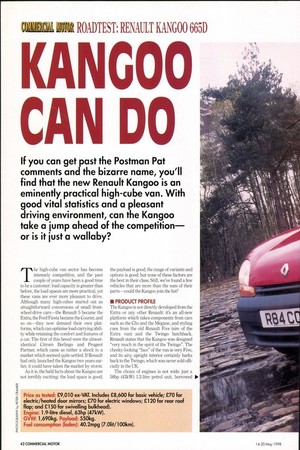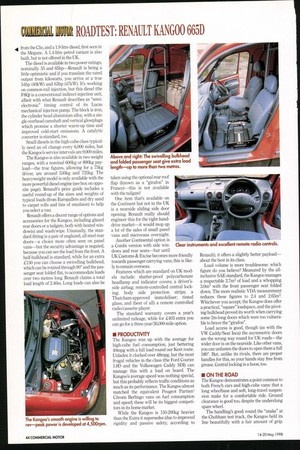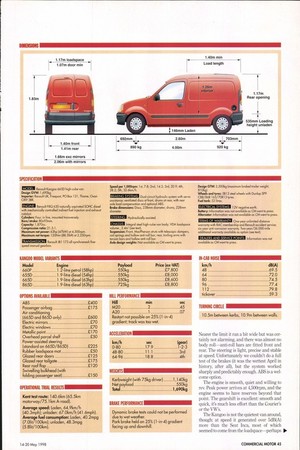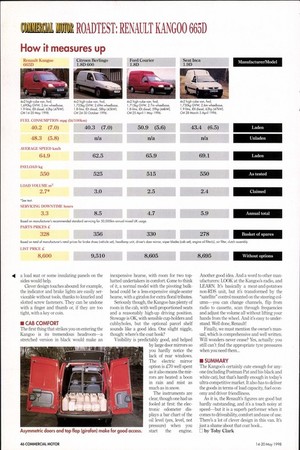1(14 14 GO N DO If you can get past
Page 54

Page 56

Page 57

Page 58

If you've noticed an error in this article please click here to report it so we can fix it.
the Postman Pat comments and the bizarre name, you'll find that the new Renault Kangoo is an eminently practical high-cube van. With good vital statistics and a pleasant driving environment, can the Kangoo take a jump ahead of the competition— or is it just a wallaby?
Price as tested £9,010 ex-VAT. Includes £8,600 for basic vehicle; £70 for electric/heated door mirrors; £70 for electric windows; £120 for rear roof flap; and £150 for swivelling bulkhead).
Engine: 1.9-litre diesel, 63hp (47kW).
GVW: 1,690kg. 550kg.
Fuel consumption (laden): 40.2mpg (7.01it/100km). The high-cube van sector has become intensely competitive, and the past couple of years have been a good time to be a customer: load capacity is greater than before, the load spaces are more practical, yet these vans are ever more pleasant to drive. Although many high-cubes started out as straightforward conversions of small frontwheel-drive cars—the Renault 5 became the Extra, the Ford Fiesta became the Courier, and so on—they now demand their own platforms, which can optimise load-carrying ability while retaining the comfort and features of a car. The first of this breed were the almostidentical Citroen Berlingo and Peugeot Partner, which came as rather a shock to a market which seemed quite settled. If Renault had only launched the Kangoo two years earlier, it could have taken the market by storm.
As it is, the bald facts about the Kangoo are not terribly exciting: the load space is good; the payload is good; the range of variants and options is good; but none of these factors are the best in their class. Still, we've found a few vehicles that are more than the sum of their parts—could the Kangoo join the list?
• PRODUCT PROFILE The Kangoo is not directly developed from the Extra or any other Renault: it's an all-new platform which takes components from cars such as the Clio and the Megane, and styling cues from the old Renault Five (sire of the Extra van) and the Twingo hatchback. Renault states that the Kangoo was designed "very much in the spirit of the Twingo". The cheeky-looking "face" of the van is very Five, and its airy, upright interior certainly harks back to the Twingo, which was never sold officially in the UK.
The choice of engines is not wide: just a 58hp (43kW) 1.2-litre petrol unit, borrowed from the Clio, and a 1.9-litre diesel, first seen in the Megane. A 1.4-litre petrol variant is also built, but is not offered in the UK.
The diesel is available in two power ratings, nominally 55 and 65hp—Renault is being a little optimistic and if you translate the rated output from kilowatts, you arrive at a true 54hp (40kW) and 63hp (47kW). It's working on common-rail injection, but this diesel (the F8Q) is a conventional indirect-injection unit, albeit with what Renault describes as "semielectronic" timing control of its Lucas mechanical injection pump. The block is iron, the cylinder head aluminium alloy, with a single overhead camshaft and vertical glowplugs which promise a shorter warm-up time and improved cold-start emissions. A catalytic converter is standard, too.
Small diesels in the high-cube class typically need an oil change every 6,000 miles, but the Kangoo's service intervals are 9,000 miles.
The Kangoo is also available in two weight ranges, with a nominal 600kg or 800kg payload—the true figures, allowing for a 75kg driver, are around 550kg and 725kg. The heavyweight model is only available with the more powerful diesel engine (see box on opposite page). Renault's price guide includes a useful round-up of the sizes and weights of typical loads (from Europallets and dry sand to carpet rolls and tins of emulsion) to help you select a van.
Renault offers a decent range of options and accessories for the Kangoo, including glazed rear doors or a tailgate, both with heated window(s) and wash/wipe. Unusually, the standard fitting is a pair of unglazed, all-steel rear doors—a choice more often seen on panel vans—but the security advantage is negated, because you can see the load from the front. A half-bulkhead is standard, while for an extra £150 you can choose a swivelling bulkhead, which can be rotated through 90° and the passenger seat folded flat, to accommodate loads over two metres long. Renault claims a total load length of 2.46m. Long loads can also be taken using the optional rear roof flap (known as a "girafon" in France)—this is not available with the tailgate!
One item that's available on the Continent but not in the UK is a nearside sliding side door opening. Renault really should engineer this for the right-handdrive market—it would mop up a lot of the sales of small panel vans and microvans overnight.
Another Continental option is a Combi version with side windows and rear seats—but until UK Customs & Excise becomes more friendly towards passenger-carrying vans, this is likely to remain overseas.
Features which are standard on UK models include: shatter-proof polycarbonate headlamp and indicator covers; a driver'sside airbag; remote-controlled central locking; body side protection strips; a Thatcham-approved immobiliser; tinted glass; and (best of all) a remote controlled radio/cassette player.
The standard warranty covers a year's unlimited mileage, while for £403 extra you can go for a three-year/36,000-mile option.
• PRODUCTIVITY The Kangoo was up with the average for high-cube fuel consumption, just bettering 40mpg with a full load round our Kent route. Unladen it clocked over 48mpg, but the most frugal vehicles in the class (the Ford Courier 1.8D and the Volkswagen Caddy SDI) can manage this with a load on board. The Kangoo's average speed was nothing special, but this probably reflects traffic conditions as much as its performance. The Kangoo almost matched the equivalent Peugeot Partner/ Citroen Berlingo vans on fuel consumption and speed; these will be its biggest competitors in its home market.
While the Kangoo is 150-200kg heavier than the Extra it supersedes (due to improved rigidity and passive safety, according to Renault), it offers a slightly better payload— about the best in its class.
Load volume is more troublesome: which figure do you believe? Measured by the allinclusive SAE standard, the Kangoo manages a respectable 2.7m3 of load and a whopping 3.0m3 with the front passenger seat folded down. The more realistic VDA measurement reduces these figures to 2.4 and 2.65m3. Whichever you accept, the Kangoo does offer a practical, "square" loadspace, and the pivoting bulkhead proved its worth when carrying some 2m-long doors which were too vulnerable to brave the "girafon".
Load access is good, though (as with the VW Caddy/Seat Inca) the asymmetric doors are the wrong way round for UK roads—the wider door is on the nearside. Like other vans, you can unfasten the doors to open them a full 180°. But, unlike its rivals, there are proper handles for this, so your hands stay free from grease. Central locking is a boon, too.
• ON THE ROAD The Kangoo demonstrates a point common to both French cars and high-cube vans: that a long wheelbase and soft, long-travel suspension make for a comfortable ride. Ground clearance is good too, despite the underslung spare wheel.
The handling's good: round the "snake" at the Chobham test track, the Kangoo held its line beautifully with a fair amount of grip. Nearer the limit it ran a bit wide but was certainly not alarming, and there was almost no body roll—anti-roll bars are fitted front and rear. The steering is light, precise and stable at speed. Unfortunately we couldn't do a full test of the brakes (it was the wettest April in history, after all), but the system worked sharply and predictably enough. ABS is a welcome option.
The engine is smooth, quiet and willing to rev. Peak power arrives at 4,500rpm, and the engine seems to have reserves beyond that point. The gearshift is excellent: smooth and quick, it's much less effort than the Courier's or the VW's.
The Kangoo is not the quietest van around, though: at speed it generated over 5dB(A) more than the Seat Inca, most of which seemed to come from the loadspace—perhaps a load mat or some insulating panels on the sides would help.
Clever design touches abound: for example, the indicator and brake lights are easily serviceable without tools, thanks to knurled and slotted screw fasteners. They can be undone with a finger and thumb or, if they are too tight, with a key or coin.
• CAB COMFORT The first thing that strikes you on entering the Kangoo is its tremendous headroom-a stretched version in black would make an inexpensive hearse, with room for two tophatted undertakers in comfort. Come to think of it, a normal model with the pivoting bulkhead could be a less-expensive single-seater hearse, with a girafon for extra floral tributes.
Seriously though, the Kangoo has plenty of room in the cab, with well-proportioned seats and a reasonably high-up driving position. Stowage is OK, with sensible cup-holders and cubbyholes, but the optional parcel shelf sounds like a good idea. One slight niggle, though: where's the coat hook?
Visibility is predictably good, and helped by large door mirrors so you hardly notice the lack of rear windows. The electric mirror option is £70 well spent as it also means the mirrors are heated: a boon in rain and mist as much as in snow.
The instruments are clear, though one had us fooled at first: the electronic odometer displays a bar chart of the oil level (yes, level, not pressure) when you start the engine. Another good idea. And a word to other manufacturers: LOOK at the Kangoo's radio, and LEARN. It's basically a meat-and-potatoes non-RDS unit, but it's transformed by the "satellite" control mounted on the steering column-you can change channels, flip from radio to cassette, scan through frequencies and adjust the volume all without lifting your hands from the wheel. And it's easy to understand. Well done, Renault!
Finally, we must mention the owner's manual, which is comprehensive and well written. Will wonders never cease? Yes, actually: you still can't .find the appropriate tyre pressures when you need them...
• SUMMARY The Kangoo's certainly cute enough for anyone (including Postman Pat and his black and white cat), but that's hardly enough in today's ultra-competitive market. It also has to deliver the goods in terms of load capacity, fuel economy and driver friendliness.
As it is, the Renault's figures are good but hardly outstanding, and it's a touch noisy at speed-but it is a superb performer when it comes to driveability, comfort and ease of use. There's a lot of clever design in this van. It's just a shame about that coat hook...
by Toby Clark




































































































































